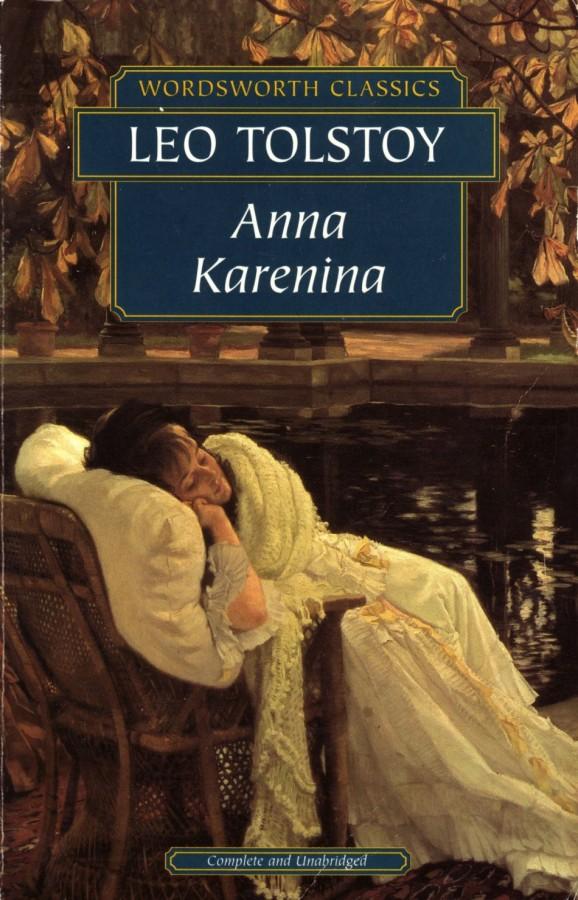Anna Karenina Review
January 17, 2015
Charlie Arnedt, Staff Writer
Rarely is there a time when such a vast, complex, and significant piece of literature is created. Anna Karenina, written by Leo Tolstoy and first published as a complete work in 1878, is one of these novels. A giant of a novel, exceeding 900 pages and having a total of eight individual parts, Anna Karenina is considered to be one of the greatest pieces of literature ever written, as well as, one of (if not the) greatest work of Tolstoy. Similar to my previous review of Les Miserables, the scope of Anna Karenina is remarkable, and is one of the key facets that compose Tolstoy’s unique writing style. However, what manages to separate Karenina from other great novels is the eloquent and relatable way in which Tolstoy portrays and conveys the consciences of his characters. To put it simply, the way Tolstoy puts the reader in the character’s mind is unparalleled. That, along with other fantastic parts of Karenina, make it a great piece of art.
Now, what is the novel about? The broad way to summarize the novel is it is about the lives of various Russian socialites in the late 19th century and their personal struggles and dilemmas. Specifically, and this is where the novel gets its title, the life of Anna Arkadyevna Karenina and her affair with Count Alexei Vronsky. The other character which the novel focuses on the most is Konstantin Levin, a landowner who faces struggles with his personal life, mainly his family and the woman he wishes to marry, Kitty Shcherbatskaya. There are a couple more important characters who are important in either storyline, but I won’t go into specific detail about each of them like a monotonous professor like in Ferris Bueller’s Day Off (Bueller… Bueller…).
One of the enjoyable, and at times bitter, parts of Anna Karenina is its realistic style. Tolstoy does not try to romanticize or sugarcoat the issues throughout the novel. The main protagonist, who is married and has a son, has an extramarital affair with a well-known Count and military officer (Vronsky). Everything will be alright, right? No, not really. In fact, the famous opening lines of the novel-which are both profound in their relevance in the real world and in the novel-answer this idealistic question. “All happy families are alike; each unhappy family is unhappy in its own way.” There is little that is interesting in the lives of a happy family that has no issues or conflicts. It is the unhappiness which builds us, intrigues us, and reminds us how we all have some sort of pain as human beings. That might sound a bit morbid or sobering, and in some ways it is, but that is not to say there is not beauty in the world. It’s just that the beauty of life cannot come without unhappiness. So, the unhappiness and tribulations of Anna Karenina, of Count Vronsky, of Levin and Kitty and all the other characters, directly affects their decisions and the conflict in general.
As I mentioned before, the way in which Tolstoy illustrates what is going through the minds of his characters is extraordinary and relatable. With the most excellent, maddening, and anxiety-filled instances of our lives as human beings, Tolstoy paints the perfect picture of what the character is feeling. Whether it be marriage, childbirth, or struggling with the inner workings of one’s conscience, Tolstoy accomplishes all of it splendidly.
Now to the themes, what is behind the lines but always present in any great piece of art. Without a doubt the most significant theme that I picked up on while reading Anna Karenina was the difference in gender. What I mean is, the ways in which women dealt with certain issues and the way men dealt with issues were blatantly contrasting each other. The best specific example is the affair Anna and Vronsky have. As they are both well-known members of Russian society, their affair being made public has repercussions for both. For Anna, the woman, she is shunned by virtually everyone except a friend or two and her sister-in-law, Dolly. In general, the way Anna is treated because of her extramarital decision clearly damages her standing amongst her peers. This isn’t the case, however, with Count Vronsky, the man. He still manages to enjoy society, advance his career, and overall maintain a positive relationship with those in society.
Apart from the differences in gender, the themes of relationships-that is, jealousy, marriage, and fidelity-are tackled. Throughout the course of the novel, which Tolstoy again does an excellent job of describing, is the jealousy that manages to arise amongst the most compatible couples. Also, the old-world customs of marriage (and divorce) take their toll in certain ways in the novel. And, of course, fidelity is examined. The hypocrisy that comes with the infidelities of certain men (specifically Anna’s brother, Oblonsky) and the paranoia that can ensue because one partner or the other doubts the other’s love for the other. With the social implications and norms of society and Russia as a whole, the relationships between men and women (and people in general) are affected in mostly negative ways, and Tolstoy does a subtle, well-executed job of presenting and criticizing these norms.
It’s really true that with any book, and Anna Karenina in its massive size is no exception, that there is much to discuss. Needless to say, Anna has no small amount of excellent portions and magnificent passages. The unique and intriguing writing style of Leo Tolstoy, which allows readers to relate on a personal level, combined with the intricate plot and several themes, make Anna Karenina a must-read for any book lover. So please, if you have the time and want to read a truly fantastic novel, pick up Anna Karenina.

Quincy • Nov 18, 2024 at 10:58 am
I totally agree with the author’s points. Very well written article.